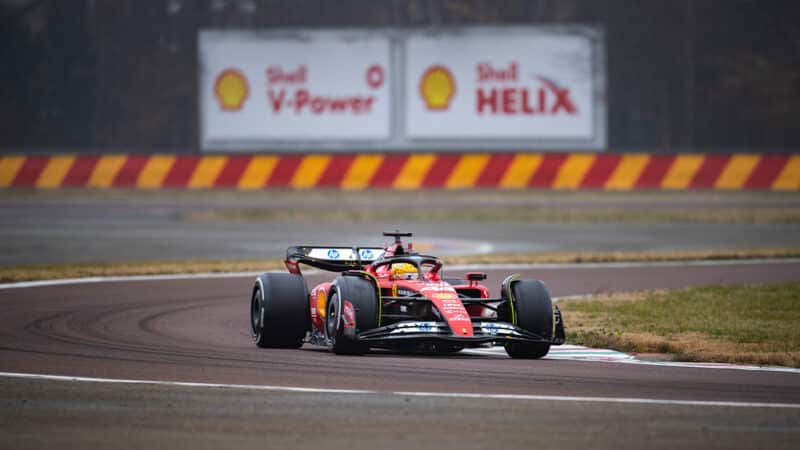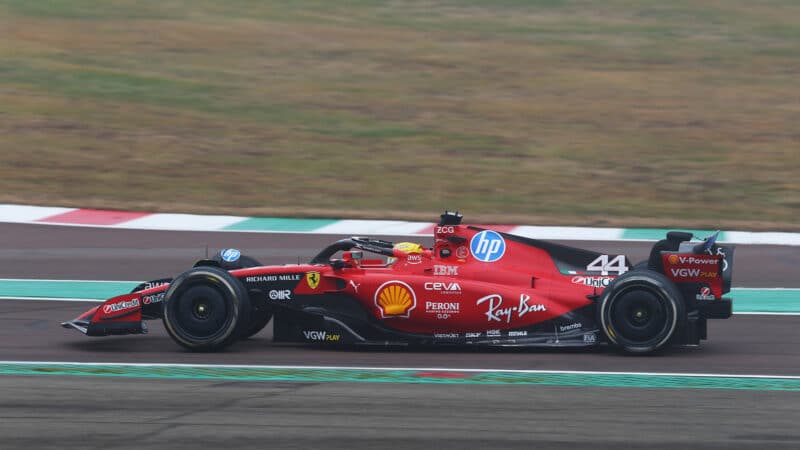Lewis Hamilton on track for Ferrari: which cars can F1 teams test?
Why is Lewis Hamilton driving a 2023 Ferrari? Here's everything you need to know about F1 testing, including what car Hamilton drove for his first test in Maranello and how far he is able to drive it

Hamilton behind the wheel of his first Ferrari: the SF-23
Ferrari
Lewis Hamilton completed his first laps behind the wheel of a Ferrari Formula 1 car on Wednesday, as the seven time-time world champion continued his high-profile introduction to the team.
In a fresh red race suit, he also revealed a new yellow helmet for 2025. But while his look was all-new, the car that he was sitting in last raced more than a year ago.
Under Formula 1’s current rules and regulations, teams are limited in what cars they can test and for how long — a rule established to reduce costs and create a more level playing field.
Stepping into a new era 👊
Lewis Hamilton takes his first lap in a Ferrari! pic.twitter.com/LCOws2haSn
— Scuderia Ferrari HP (@ScuderiaFerrari) January 22, 2025
It means that Hamilton’s mileage will be restricted this week — even in the 2023-spec car that he’s driving — to avoid a return to the extravagances of the past.
Previously, big budget teams such as Ferrari, McLaren and Williams were able to conduct an unlimited amount of testing with their current car — and prospered on-track as a result — while smaller teams could only afford to conduct smaller tests and consequently struggled.
Below, we detail how teams test in the modern era; the cars they are allowed to use and how far they can be driven.
What cars can F1 teams test?
| Testing type | Cars models allowed | Distance allowed |
| Testing of Current Cars (TCC) | 2024, 2025 | n/a |
| Testing of Previous Cars (TPC) | 2023, 2022, 2021 | 1000km |
| Testing of Historic Cars (THC) | 2019 – 1950 | Unlimited |
| TCC Promotional Events | 2024, 2025 | 200km |
| Demonstration Events | 2024, 2025 | 15km |
| 2022, 2021, 2020 | 50km |
What Ferrari did Lewis Hamilton test in Maranello?

Hamilton drove the SF-23 for his first lap of Fiarano
F1
On Wednesday, January 22, Lewis Hamilton completed his first on-track test for Ferrari in the SF-23 — Maranello’s 2023 F1 model.
The test was conducted under the ‘Testing of Previous Cars’ rule, which allows drivers entered in the world championship to drive cars which last between two and four seasons ago.
Under the TPC rules, Hamilton is allowed to drive the SF-23, the F1-75 (Ferrari’s 2022 F1 model) or the SF-21 (Ferrari’s 2021 F1 model) for his first test around Fiorano.
There are also restrictions on distance. Active F1 drivers are only allowed to drive these recent cars for a maximum of 1000km over four days.
If Ferrari were to give Hamilton the entire allowance, he could theoretically complete 333.6 laps of the 2.99km Fiarano circuit over the next four days. But with Charles Leclerc likely wanting some time behind the wheel too, Hamilton may be confined to just one or two days of testing.
There are, however, other ways that Ferrari can get Hamilton some more time behind the wheel, prior to the season — both in its upcoming 2025 model as well as in older cars.
Rules on testing F1 cars
Testing of Current Cars (TCC)
Current cars are defined as those designed and built for the current or previous F1 season, and testing is usually carried out twice a year.
Pre-season testing
This takes place each year on three consecutive days, typically in late February, to allow teams to hone their new cars. They can only use one car in this test. Mileage isn’t limited, but the length of the sessions are: nine hours of track time is allowed each day between 9am and 7pm.
Post-season testing
Teams will only be allowed to test with one car during the post-season Abu Dhabi test in 2025, which the regulations state must start within 36 hours of the end of the final grand prix of the year.
It will be a rookie test, as testing can only be carried out by young drivers — classed as those who haven’t raced in more than two grands prix.
Last year, teams were allowed to use two cars during the test; one of which had to be driven by a young driver
Reserve driver testing
If a team replaces one of its drivers with a rookie mid-season, it’s allowed to carry out a single-day test session to get their new driver up to speed before their first race.
This only applies if the replacement driver hasn’t taken part in a grand prix in the previous two years. So Liam Lawson wasn’t eligible when he replaced Daniel Ricciardo last year, as he had substituted for him in 2023.
If teams arrange a test for a replacement driver and then decide not to race them, they will be penalised by losing one day of the following year’s pre-season test.
Tyre testing
In 2025, ten days of tyre tests are permitted, co-ordinated with teams, the FIA and Pirelli, F1’s sole tyre supplier.
Testing is typically divided between the teams and is led by Pirelli in order to test new tyre compounds.
Testing of mule cars
In addition to the conventional tyre tests, Pirelli is asking teams to run “mules” — current cars that are adapted to replicate next year’s contenders which will be built to a new ruleset.
This began last year when Aston Martin tested the new 2026 specification of narrower tyres at Barcelona.
Up to 40 days of these tests are permitted in 2026. Pirelli will decide whether it needs to use the full allocation
Testing of Previous Cars (TPC)
Teams can carry out up to 20 days of testing per year in “previous cars” — classed as those which are between two and four years old.
However, there are tighter restrictions for existing F1 drivers, or drivers that teams “intend” to enter in the championship: each F1 team can only carry out 1000km of TPC over a maximum of four days for all of its current and future drivers
That means the allowance can quickly be used when getting new drivers up to speed, whether that’s Lewis Hamilton at Ferrari or Mercedes throughout 2024 as it prepared Kimi Antonelli for his rookie season in 2025 with the the W13 (Mercedes’ 2022 F1 car).
When tested, each car must be constructed to the specification of the period — meaning that teams cannot test new parts that could be used on current machines.
All TPC testing must be conducted between the hours of 9am to 7pm on a FIA Grade 1 circuit, as long as it is not hosting a race within the next 60 days.
Testing Historic Cars
Under the Testing of Historic Cars rule, F1 teams are allowed to do unlimited running with cars which were built five years previous to the current season and older.
This is why Kimi Antonelli ran a 2020 Mercedes at Jerez at the start of 2025, it being the most recent car which doesn’t fall under the newly-limited mileage of the TPC.
Testing these older cars – particularly for newer drivers that teams want to get up to speed – may now become more popular as the TPC outings have become limited for this season: 20 days per year for each squad, with current race drivers limited to 1000 kilometres of running.
TCC Promotional Events (PE)
A Testing of Current Cars Promotional Event (PE) is defined as “an event in which a Competitor participates purely for marketing or promotional purposes.”
The best example of this is found during the pre-season, when teams shakedown their latest creations as part of their individual launches or during filming days.
Drivers participating in a PE may not exceed 200km, and only one may be carried out per team per day.
Demonstration Events
F1 teams typically take cars that are several years old to events such as the Goodwood Festival of Speed because there are tight restrictions on this type of running for modern machines.
Each team can only carry out up to two demonstration events each year with recent cars — which can also include city centre blasts where roads are shut down, such as the one in Las Vegas in 2022. These must be approved by the FIA.
Current cars can run for only 15km (nine miles) per event, while recent cars (from the previous three years) can cover 50km (31 miles) per event.
